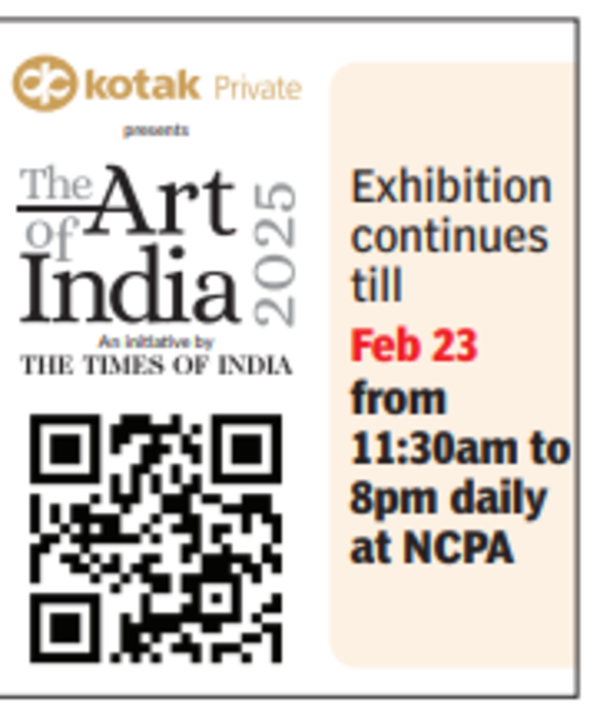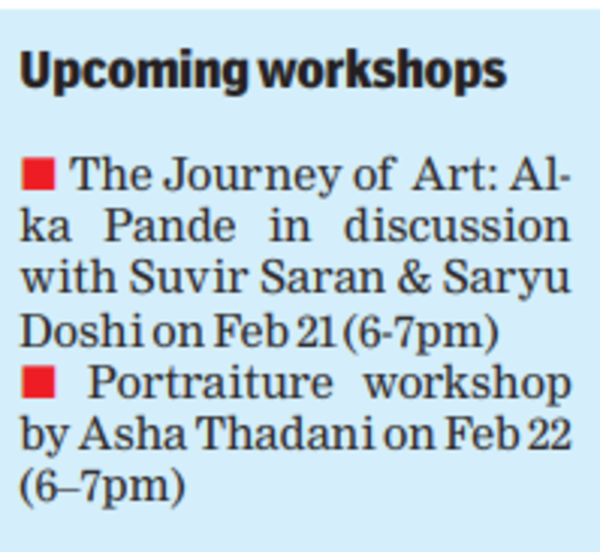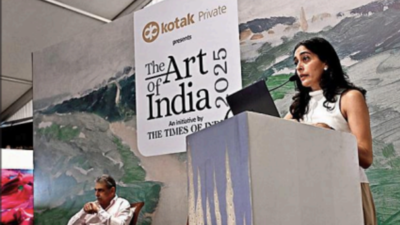Passion vs profit? Experts decode art of collecting | Mumbai News – The Times of India

What makes a great art collection? Is it the name on the canvas, the money, or something more personal? At The Times of India’s Art of India fourth edition at NCPA on Sunday, art collector and auctioneer Mallika Sagar and gallerist Dadiba Pundole unpacked these questions in a no-nonsense masterclass spanning market trends and valuations to passion and intuition for aspiring art collectors.
Sagar’s mantra was to purchase works that they like and enjoy. “We can give you the scientific part but collecting is not a science, it’s a passion,” said Sagar, whose advice to aspiring collectors was simple. “What you like is what should end up on your walls. It should be a reflection of your own tastes and your own individual journey.”
She urged collectors to be clear about their motivations— whether they were buying art for acquisition or for decorating their home or as a passion. “If everybody is buying the work by Husain, you don’t need to buy the work by Husain if you don’t like it. Make your own choices, forge your own path. It has to be works that you are happy to have, to live with, to own. And whether their value goes to zero or their value triples, you should be happy to live with that artwork.”
Sagar broke down the many ways to build a collection—by artist, subject, time period, or even by theme, such as Partition. “You can also collect by school or by region,” she added, offering examples from pre-modern, modern, and contemporary art, as well as Indian antiquities, miniature paintings, and decorative objects like furniture, glass, lights, carpets, and ceramics.

She also spoke about where to source an artwork from. “It’s not like the early days of the market, where you could go directly to the artist’s studio and buy paintings. It’s now becoming more organised and structured. So you can go to an art fair, dealer or visit a gallery. That is what we call the primary market. It is the first time that that work is being sold. The auction platform is a secondary platform.”
Sagar pointed at a significant shift in India’s art market, once dominated by non-resident Indian buyers. “Over the last few years, as the stock market and economy has grown, and as the middle class has realised that they would like to have more of an acquisitive element to their earnings and their spendings. The market here has grown tremendously, both in terms of the number of collectors buying art every year, and also the amount of money that a collector is willing to spend on a particular work of art.”
Sagar walked the audience through the repertoire of India’s best known artists including Amrita Shergil, SH Raza, Raja Ravi Varma, Tyeb Mehta, MF Husain and VS Gaitonde.
The pricing dynamics of the art market drew considerable interest. Pundole explained how public perception also influences price. A key debate emerged: If a buyer has Rs 20 lakh, should they invest in the best work of a young artist or opt for a lesser piece by a senior artist? Sagar warned against a common pitfall—taking certificates of authenticity at face value. “Certificates should not be taken as a benchmark of authenticity given how easy it was to replicate or forge them.”
“We view art as a powerful expression of culture, creativity, and heritage. With India’s art market flourishing, a new generation of patrons are embracing art as both an investment and a cultural statement. AOI is a strategic move to capitalise on the thriving art market and we’re happy to support this ecosystem for artistic excellence,” said Rohit Bhasin, president and CMO, Kotak Mahindra Bank.
What makes a great art collection? Is it the name on the canvas, the money, or something more personal? At The Times of India’s Art of India fourth edition at NCPA on Sunday, art collector and auctioneer Mallika Sagar and gallerist Dadiba Pundole unpacked these questions in a no-nonsense masterclass spanning market trends and valuations to passion and intuition for aspiring art collectors.
Sagar’s mantra was to purchase works that they like and enjoy. “We can give you the scientific part but collecting is not a science, it’s a passion,” said Sagar, whose advice to aspiring collectors was simple. “What you like is what should end up on your walls. It should be a reflection of your own tastes and your own individual journey.”
She urged collectors to be clear about their motivations— whether they were buying art for acquisition or for decorating their home or as a passion. “If everybody is buying the work by Husain, you don’t need to buy the work by Husain if you don’t like it. Make your own choices, forge your own path. It has to be works that you are happy to have, to live with, to own. And whether their value goes to zero or their value triples, you should be happy to live with that artwork.”
Sagar broke down the many ways to build a collection—by artist, subject, time period, or even by theme, such as Partition. “You can also collect by school or by region,” she added, offering examples from pre-modern, modern, and contemporary art, as well as Indian antiquities, miniature paintings, and decorative objects like furniture, glass, lights, carpets, and ceramics.
She also spoke about where to source an artwork from. “It’s not like the early days of the market, where you could go directly to the artist’s studio and buy paintings. It’s now becoming more organised and structured. So you can go to an art fair, dealer or visit a gallery. That is what we call the primary market. It is the first time that that work is being sold. The auction platform is a secondary platform.”
Sagar pointed at a significant shift in India’s art market, once dominated by non-resident Indian buyers. “Over the last few years, as the stock market and economy has grown, and as the middle class has realised that they would like to have more of an acquisitive element to their earnings and their spendings. The market here has grown tremendously, both in terms of the number of collectors buying art every year, and also the amount of money that a collector is willing to spend on a particular work of art.”
Sagar walked the audience through the repertoire of India’s best known artists including Amrita Shergil, SH Raza, Raja Ravi Varma, Tyeb Mehta, MF Husain and VS Gaitonde.
The pricing dynamics of the art market drew considerable interest. Pundole explained how public perception also influences price. A key debate emerged: If a buyer has Rs 20 lakh, should they invest in the best work of a young artist or opt for a lesser piece by a senior artist? Sagar warned against a common pitfall—taking certificates of authenticity at face value. “Certificates should not be taken as a benchmark of authenticity given how easy it was to replicate or forge them.”
“We view art as a powerful expression of culture, creativity, and heritage. With India’s art market flourishing, a new generation of patrons are embracing art as both an investment and a cultural statement. AOI is a strategic move to capitalise on the thriving art market and we’re happy to support this ecosystem for artistic excellence,” said Rohit Bhasin, president and CMO, Kotak Mahindra Bank.

















